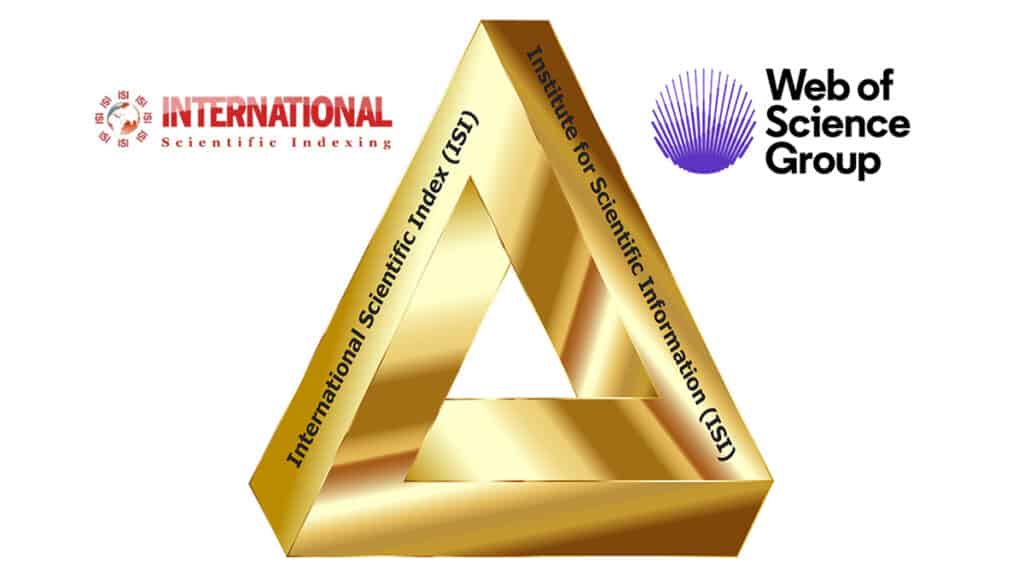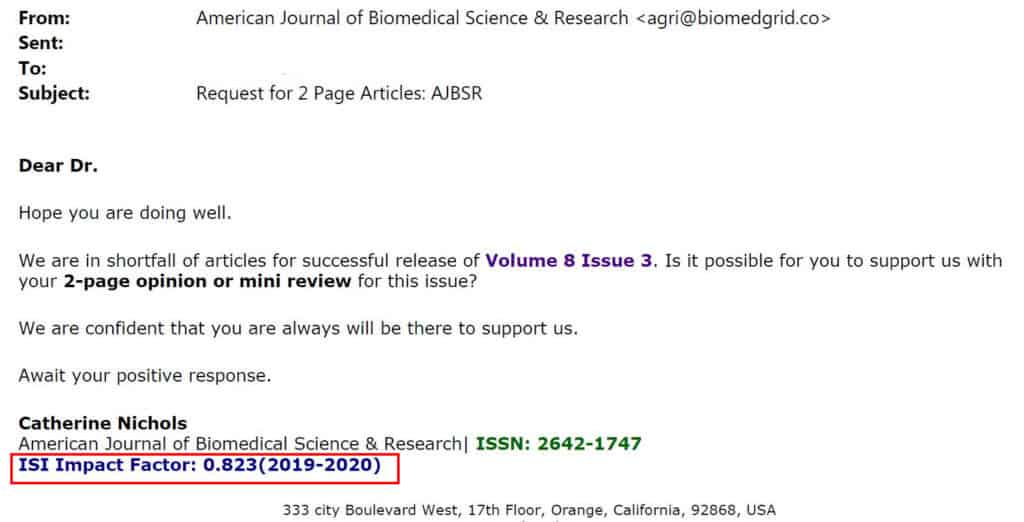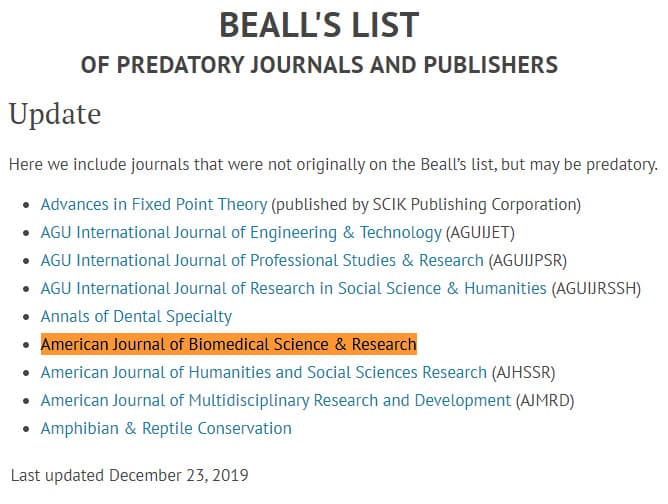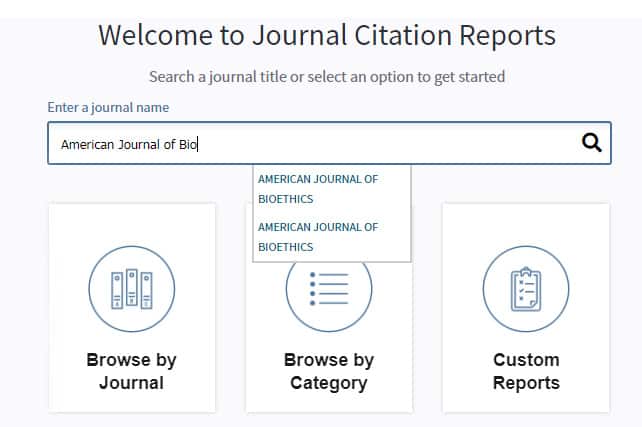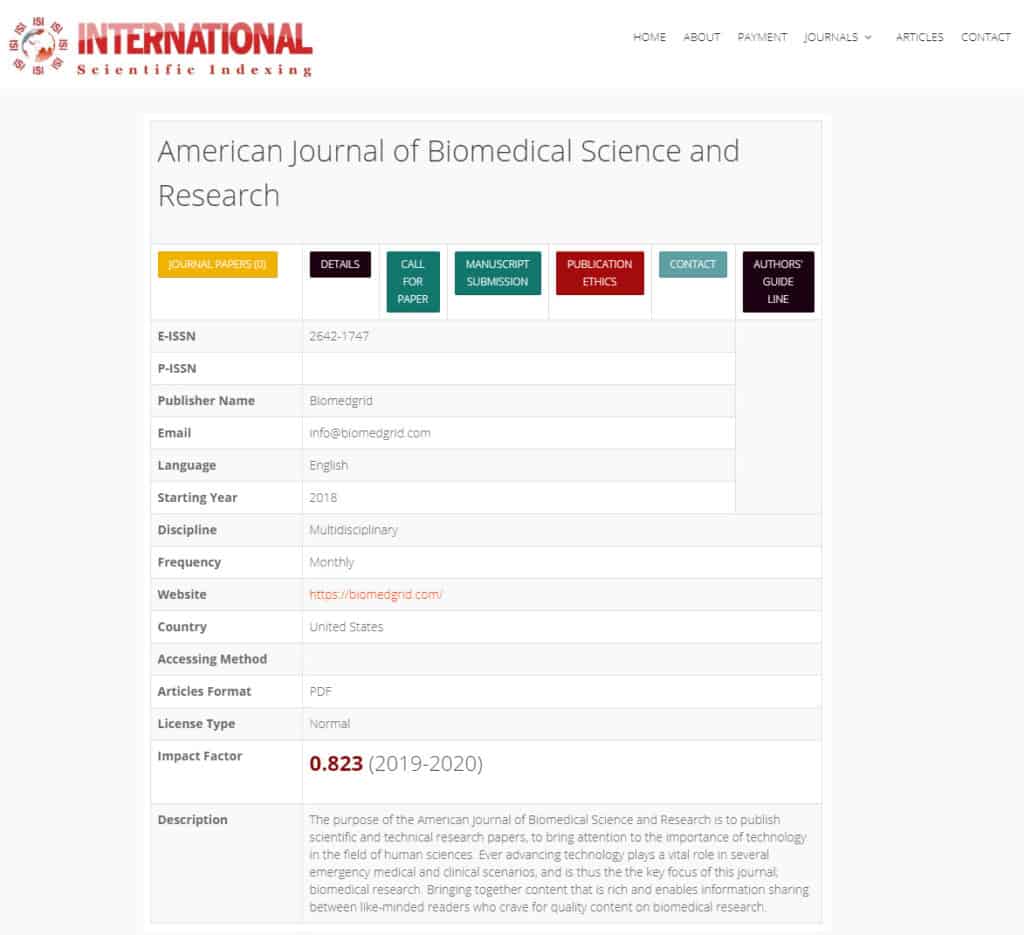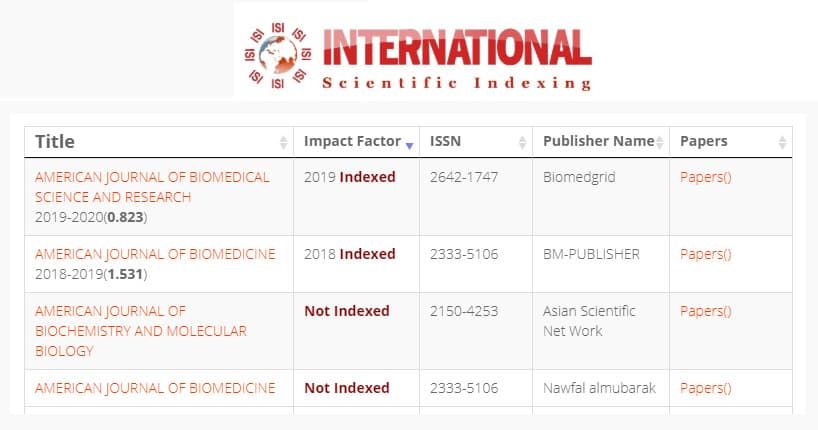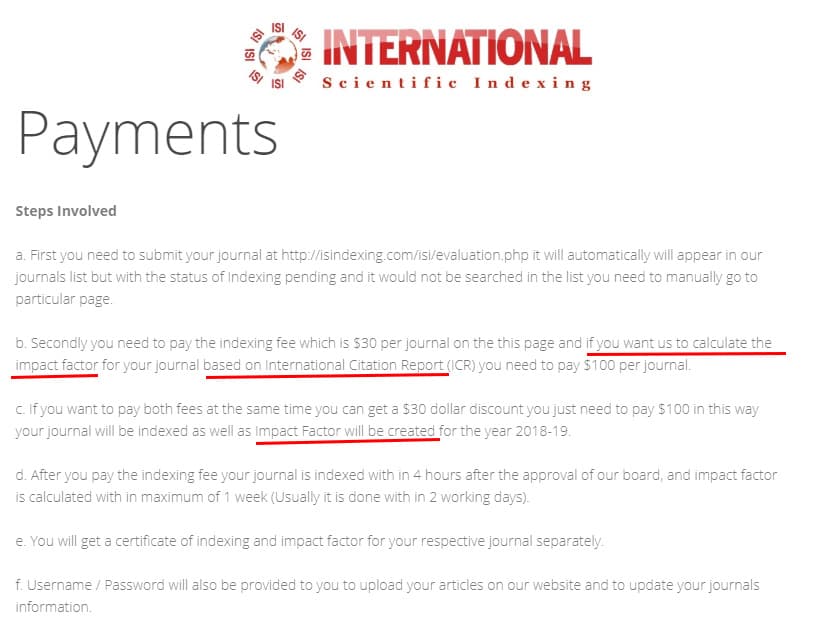We were recently sent an email (see Figure 1), where Catherine Nichols stated that the American Journal of Biomedical Science & Research had an ISI impact factor of 0.823.
The person who received this email was considering submitting as they like to publish in ISI rated journals, but they sought our opinion first.
We thought we would investigate, just to make sure that the journal’s claim is true.
Our findings? It is true but very misleading. In this article we will tell you why we believe that the claim to have an ISI impact factor of 0.823 is misleading.
If you are interested in citation analysis, you may want to take a look at this book, Citation Analysis in Research Evaluation [affiliate link].
Web of Science impact factor
This article is really about what the term “ISI” means and whether it is being misrepresented? So we thought it was worth having a brief discussion of what most people, in the academic community, would think when they hear the term “ISI”.
Web of Science is probably the most trusted, most respected and well used, impact factor. When somebody refers to an impact factor, without any other context, they are likely to be referring to Web of Science, more commonly referred to as ISI (Institute for Scientific Information) but now more correctly called the Clarivate Analytics Impact Factor.
To be totally clear, if somebody says a journal has an ISI impact factor, then it will most likely be assumed that the impact factor is the one that has been set by Web of Science.
Publishing in ISI indexed journals is important to a lot of people and a lot of institutions as it is generally accepted that ISI indexed journals represent the highest quality journals. Indeed, some institutions go as far as saying that their academics should only submit to ISI ranked journals.
The EMAIL
The email in Figure 1 was passed to us recently. We have our suspicions that the American Journal of Biomedical Science & Engineering is a predatory journal, as it is listed on an updated version of Beall’s list (see Figure 2).
However, the journal states that it has an ISI impact factor of 0.823. To most people this would mean that the journal is listed by Web of Science. Although unlikely, it is possible that a predatory journal could somehow get listed by Web of Science but if a journal is listed as a possible predatory journal and it is claiming to have an ISI impact factor it is worth taking a look at the claim that is being made.
Is the journal listed on Web of Science?
The first thing to do is to see if the journal is actually listed on Web of Science. This is easy to do, as Web of Science provides a Journal Citation Report (also known as JCR) which enables the user to look up a specific journal, as well as categories of journals.
Figure 3: Searching for a journal on Web of Science (see Figure 3) shows this search (click on the image to enlarge it). We searched for “American Journal of Bio”. As the figure shows this only returned two results, actually the same journal (American Journal of Bioethics) twice. We also searched American Journal of Biomedical Science & Research using its ISSN (2642-1747) and, as expected, the journal was not found.
Bottom line, the American Journal of Biomedical Science & Research is not a Web of Science ISI listed journal, which begs the question why the journal makes the statement that it has an ISI impact factor of 0.823.
The journal's web site
The email (Figure 1) did not provide a link to the journal’s web site, but a quick search found it. Figure 4 shows the banner for the journal’s web site. We know we have the right journal, as the ISSN is the same. We can also see that the same impact factor is being claimed (0.823).
The impact factor is a clickable link and if we follow that link, we end up on the web site of International Scientific Indexing, at the page that lists the entry for American Journal of Biomedical Science & Research (see Figure 5). This indexing service certainly has the initials ISI, but it is not what most people would think of when we say ISI, in the context of impact factors.
International Scientific Indexing
Of course, International Scientific Indexing could be a perfectly legitimate indexing service. On the other hand, it could be a way for journals that cannot get indexed by Web of Science to deceive the academic community.
We thought we would carry out a few checks.
Firstly, we searched for “American Journal of Bio”, in the same way that we searched for this phrase on Web of Science. This returned four journals (see Figure 6). It is noticeable that the American Journal of Bioethics does not appear. Whilst not every journal should appear on every legitimate list of indexed journals, we might expect to see Web of Science ISI indexed journals to appear on other lists. This is often the case, for example with Scopus. If a journal is on Web of Science, it is often on Scopus as well, although the reverse is not always true.
Further checking shows that the International Scientific Indexing only accepts open access journals in its index, which might explain why the American Journal of Bioethics does not appear. We would like to do a fuller investigation but as a quick check, we did look up Plos One (perhaps the most well-known open access journal). This is listed on Web of Science (impact factor 2.776) but it does not appear on International Scientific Indexing. This raises a red flag that is worthy of further investigation as it is a worry that one of the most well known open access journals is not listed on the International Scientific Indexing web site.
The second quick check we did was to look at how International Scientific Indexing calculates its impact factors. In a previous article, we looked at the African Quality Centre for Journals (AQCJ), which is another indexing measure. In that article, we described how Web of Science calculates its impact factor, which is both easy and transparent. AQCJ did not describe its evaluation methodology in a transparent way, which was a cause for concern.
Similarly, we could not find the evaluation methodology for the International Scientific Indexing. The only thing we could find was on the payment page (see Figure 7). The second point (b.) says if you want them to calculate your impact factor, you have to pay USD 100. There is no mention of how the impact factor is actually calculated.
Moreover, it says that the impact factor is based on the International Citation Report (ICR). If you search for this term, the first item that is displayed is Web of Science’s Journal Citation Report. The cynical side of us thinks that this may be another attempt to confuse the unwary that the Web of Science ISI impact factor and the International Scientific Indexing impact factor are the same thing.
Conclusion
After seeing the email that was sent to us, and carrying out our investigation, we believe that International Scientific Indexing are trying to misrepresent themselves as being the Web of Science ISI impact factor. Whilst a few clicks can determine that they are not Web of Science, the fact that International Scientific Index, and the journals they index, refers to them as “ISI”, in legal terms could be considered as “passing off”, which is somebody misrepresenting goods or services as being the goods and services of another. For anybody who would like a deeper legal understanding, you might want to take a look at books such as “A User’s Guide to Trade Marks and Passing Off” (Amazon link here).
We hope that this is not the case but we would urge International Scientific Indexing to use their full name in any correspondence, and encourage their subscribers to do the same. They should not use an acronym, which is in common day use within the scientific community, but for a different, yet similar service.
We would also urge International Scientific Indexing to publish their methodology as to how their impact factor is calculated. Web of Science do this, so why should other indexes services not follow their lead.
Until International Scientific Indexing are more open about who they are, and they publish their evaluation methodology, we would suggest that the scientific community just ignores this impact factor as it confusing in the way that it could be thought of as Web of Science and the fact that its methodology is not available makes it meaningless as they could be just be picking random numbers.
If you have had your journal indexed by International Scientific Indexing, you might be told how your impact factor is calculated. If this is the case, we would love you to get in touch.
In summary, the International Scientific Indexing should be treated with extreme caution and it is probably best just to ignore it as its impact factor has no meaning.
Please consider supporting us by becoming a patron

Thank you for reading this article. If you would like to support the work we do, please consider becoming one of our patrons.
With your support, it will enable us to deploy some of the ideas that we have, and will also enable us to work more closely together. As an example, we will look at journals and/or publishers that you propose. You can read more here.
